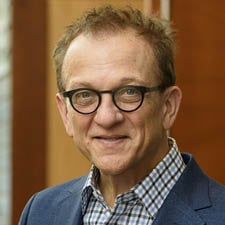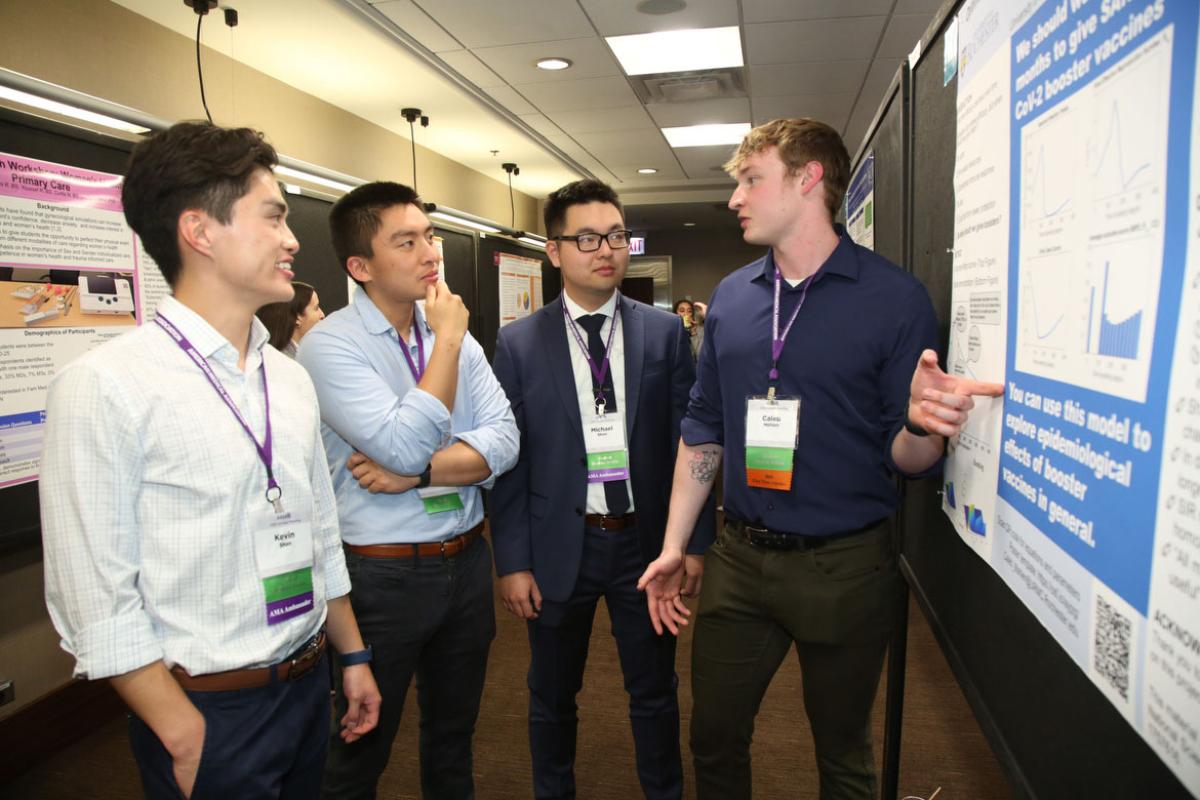As a medical student, do you ever wonder what it's like to specialize in preventive medicine? Meet AMA member James Jerzak, MD, a family physician and a featured doctor in the AMA's "Shadow Me" Specialty Series, which offers advice directly from physicians about life in their specialties. Check out his insights to help determine whether a career in family medicine might be a good fit for you.
The AMA's Specialty Guide simplifies medical students' specialty selection process, highlights major specialties, details training information, and provides access to related association information. It is produced by FREIDA™, the AMA Residency & Fellowship Database®, which allows you to search for a residency or fellowship from more than 12,000 programs—all accredited by the Accreditation Council for Graduate Medical Education.
Learn more with the AMA about the medical specialty of family medicine.
"Shadowing" Dr. Jerzak
Specialty: Family medicine.
Practice setting: Group.
Employment type: Part of a 30-location primary care group employed by Bellin Health, based in Green Bay, Wisconsin.
Years in practice: 35.
A typical day and week in my practice: My typical day has evolved over the years. For 15 years I delivered babies, so I usually started the day at the hospital making rounds. That was a rewarding part of practice, and certainly helps develop close relationships with patients. It's really cool that I am now seeing children of patients I delivered.
I usually get to the office by about 7 a.m. I meet with my team, and we review the in-basket for results and other leftover items from the previous day. We then have a brief team huddle, where we review the day's schedule, identify spots for additional patient access, and try to anticipate needs of patients that day.
At Bellin, we have been an early adopter of the team-based care movement that is emerging—to combat burnout, as well as to improve the care of our patients. One part of this transformation has been a redesign of the office visit, empowering our medical assistants (MAs) and licensed practical nurses (LPNs) to take on expanded roles.
They take a more active role in quality measure improvement, and they often stay in the room with me to do most of the documentation, medication refill pending, and other work in the electronic health record. This frees me up to give my full attention to the patient, without having to worry about the data entry work that contributes to burnout.
This new model of team-based care also involves changing our approach to in-basket work. This work is now done by a variety of members, each working at the top of their skill set. Rather than finishing work at home in the evening, I almost always get the work done by the time I leave the office—a game changer.
The final component of our team-based care work is the development of an extended care team of ancillary support—case managers, diabetes educators, clinical pharmacists, and others—who help with the care of our patients with complex problems or social determinant of health needs. Bottom line is that this team-based approach has made a difference in the care of our patients and has led to a big improvement in work-life balance for our docs.
At Bellin, doctors typically work four days a week. I am in a call group with call once in 22 days. With the telephone triage by RNs, and the presence of hospitalists, there are few calls—a huge change from a few years ago.
The most challenging and rewarding aspects of family medicine: One of the most challenging aspects in primary care is that patients rarely present to you with textbook symptoms, so there is always some element of uncertainty you must deal with. But the big advantage in primary care is the ability to follow up with our patients. We'll frequently call our patients back for updates on their condition or schedule a follow-up appointment to make sure their issues are resolving.
One other challenge is how patient care in the primary care office has changed over the years, in terms of more complex patients. Early hospital discharges, emphasis on avoiding nursing home care, the aging of the population and the increase in chronic disease—led by diabetes—has made ambulatory care much more complicated. In the past I would see 30 to 35 patients a day, now 20 to 25 patients is a challenge. Of course, that's what makes the move to team-based care so important.
Now that I have been in Green Bay for a while, I know most of my patients really well. That has to be the most rewarding part of family medicine, as you get to care for—or coordinate care for—patients of any age, with any condition. We always find time to chat about the Packers, or other nonclinical things—one day I complained about my problems growing tomatoes to a farmer, and the next day I had a load of horse manure in my driveway.
And I love the day that my first patient was a newborn check, and my next patient was 102 years old. Seeing children of patients that I have cared for—as well as their parents and grandparents—you just can't get more rewarding than that.
How life in family medicine has been affected by the global pandemic: Obviously the pandemic has had far reaching effects on all aspects of medicine—and society. One good thing that came out of it was the development of a system-wide task force to deal with the rapidly evolving situation. It was the closest that I have ever seen primary care, specialty care, administrative folks, and hospital departments working together to meet challenges.
Of course, the rapid development of virtual visits was a challenge, both technically as well as getting docs and patients comfortable with this change. The political divide in terms of masking and vaccines has been difficult. I have had patients who refused the vaccine and ended up dying from COVID. Heartbreaking.
The long-term impact the pandemic will have on family medicine: The impact will be far-reaching. Virtual medicine is here to stay, though in what capacity and what volume remains to be determined. There is a huge push for technological innovations that will impact the future of care, including wearable devices, virtual monitoring, and other currently unimaginable advances. Primary care docs will need to be nimble to accurately assess and then implement those advances that have real, practical benefits for patients.
As with any chronic disease, primary care docs will play a key role in providing care for the many patients with long COVID. With the assistance of technological advances, more care will be delivered in home settings—look at the emerging hospital at home programs. And the ongoing push to move from fee-for-service payments to value-based payments will make the role of primary care docs even more important. Team-based care provides the means to meet all these challenges.
Three adjectives to describe the typical family physician: Caring. Empathetic. Adaptable.
How my lifestyle matches, or differs from, what I had envisioned: When I first got into practice, I totally expected it to be busy and hectic, and it was, and I loved it. My wife also worked full time, so it was a challenge raising three kids during that time. But it was a good challenge, and we really embraced it.
As time went on, things tend to change. I liked having established patients that I knew well, we got into traveling, and enjoyed more time for recreational activities. The change to team-based care came just at the right time, since it really does provide a sustainable work-life balance.
Skills every physician in training should have for family medicine but won't be tested for on the board exam:
- Empathy, empathy, empathy. The ability to put yourself in your patients' shoes is really crucial.
- You get a late CT scan result—think of how stressed the patient is waiting to hear—you could call tomorrow, but get it done now.
- You get a patient call about a child with a runny nose. Don't get frustrated—realize that parent is at the end of what they can handle and needs advice.
- Are you running behind? Take a deep breath, and slow down. Don't let yourself show that you are rushed. Think of how that makes the patient feel.
- As I tell students, you may be busy and stressed, but remember this next patient may be one of 25 for you, but for them, it is a big deal to see a doctor, and they might remember that visit the rest of their life. Give them your full attention.
One question physicians in training should ask themselves before pursuing family medicine: Do I enjoy getting to know people well? Would it be rewarding for me to develop meaningful and long-lasting relationships with patients? Would I enjoy being the leader of a team of health care professionals, working together to care for a wide variety of patients?
Books every medical student interested in family medicine should be reading: Heirs of General Practice, by John McPhee. It gives you a look at where family medicine came from, and the amazing work the general practitioners of previous generations did with minimal resources.
Anything by Atul Gawande, MD. He is a visionary, and eloquent voice, looking for solutions for the problems facing medicine today.
Growing body of literature about team-based care. Learn the specifics of how this is effectively dealing with burnout and improving patient care. Especially anything by Christine Sinsky, MD, or Tom Bodenheimer, MD, two national leaders in this transformation.
The Book Thief, by Markus Zusak. It's important to stay well-rounded. Don't just read medical books. This book is a gripping and moving story of resilience in the face of unimaginable hardship.
The online resource students interested in family medicine should follow: Up to Date is a practical and easily accessible reference for busy clinicians. Prescriber’s Letter is a practical source of up-to-date advice about medications—it’s a really helpful resource.
Quick insights I would give students who are considering family medicine: The variety of options for family doctors coming out of training is amazing. It's likely that you could get a job any place in America. It's also likely that the importance of primary care in general, and family medicine in particular, will continue to grow as payments move away from volume and procedures, towards quality and value.
And don't be discouraged by things you might read about physician burnout—there are lots of steps being taken to deal with this. This is an exciting time in medicine, as there are so many clinical advances, and as a major focus of health care delivery is taking work-life balance for physicians and other health care workers seriously. I can't imagine a more rewarding career.




